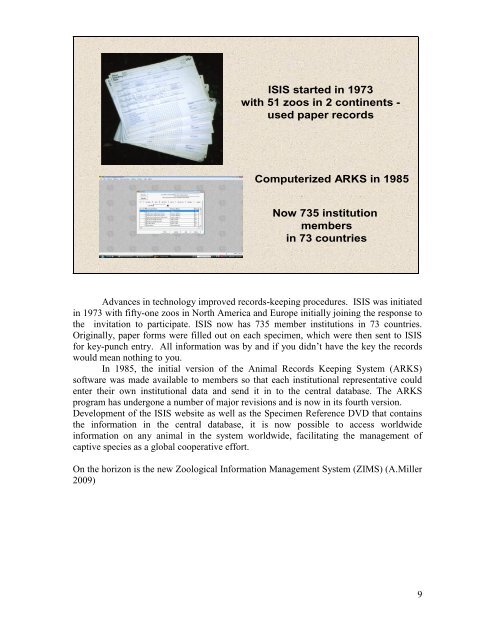standardization of records keeping in indian zoos - Central Zoo ...
standardization of records keeping in indian zoos - Central Zoo ... standardization of records keeping in indian zoos - Central Zoo ...
The objective of this paper is to provide comprehensive review of the different techniques for marking different species of animals and their subsequent record keeping. I hope this paper will act as a guide for the selection of effective marking system for animal identification and also an effective way of keeping records of individual animal. History and Evolution of Records Keeping Historically: Basic inventory – births, deaths, acquisitions and dispositions kept in log books Little ability to retrieve information Cooperative animal records keeping is a relatively new process evolving into a global collection of captive animal information. Few animal collections kept animal records when the first zoos were established. Records were limited to basic inventory information: the numbers of animals that came in or went out, died or were born. This is a Milwaukee County Zoo collection log dating back to the 1800s. Rarely were records kept on individual animals. Written records were kept in logbooks and daily reports, and were primarily for archival purposes rather than applied animal management use. Paper records were not conducive to information retrieval largely due to inconvenience - storage, sorting, and collating. 8
ISIS started in 1973 with 51 zoos in 2 continents - used paper records Computerized ARKS in 1985 Now 735 institution members in 73 countries Advances in technology improved records-keeping procedures. ISIS was initiated in 1973 with fifty-one zoos in North America and Europe initially joining the response to the invitation to participate. ISIS now has 735 member institutions in 73 countries. Originally, paper forms were filled out on each specimen, which were then sent to ISIS for key-punch entry. All information was by and if you didn‟t have the key the records would mean nothing to you. In 1985, the initial version of the Animal Records Keeping System (ARKS) software was made available to members so that each institutional representative could enter their own institutional data and send it in to the central database. The ARKS program has undergone a number of major revisions and is now in its fourth version. Development of the ISIS website as well as the Specimen Reference DVD that contains the information in the central database, it is now possible to access worldwide information on any animal in the system worldwide, facilitating the management of captive species as a global cooperative effort. On the horizon is the new Zoological Information Management System (ZIMS) (A.Miller 2009) 9
- Page 1 and 2: STANDARDIZATION OF RECORDS KEEPING
- Page 3 and 4: Acknowledgements The present projec
- Page 5 and 6: 3.Part- II- Marking of Animals for
- Page 7: Executive Summary The present repor
- Page 11 and 12: ACCESSION NUMBER Accession No.= Loc
- Page 13 and 14: used only if you decide to add the
- Page 15 and 16: DEACCESSION - The process by which
- Page 17 and 18: B. KEEPER’S DIARY Most of the zoo
- Page 19 and 20: Name of the Zoo- Keeper ___________
- Page 21 and 22: Recommended Daily Report with ficti
- Page 23 and 24: Note: a) Date of Birth - if the ani
- Page 25 and 26: Recommended studbook to be maintain
- Page 27 and 28: Picture1: Cabinets for holding Medi
- Page 29 and 30: ANIMAL VACCINATION CARD Species- Ho
- Page 31 and 32: ANIMAL DEWORMING CARD Species- Hous
- Page 33 and 34: ___________________________________
- Page 35 and 36: - Survey/questionnaires - Keeper Re
- Page 37 and 38: Unfortunately it doesn‟t exist. T
- Page 39 and 40: individual. Photographs are well su
- Page 41 and 42: applied with pliers that flatten a
- Page 43 and 44: may be easier to read but the ink w
- Page 45 and 46: IV. Tag loss is primarily attribute
- Page 47 and 48: ensure even contact (uneven contact
- Page 49 and 50: Cow 2-10 weeks 10 secs Macpherson a
- Page 51 and 52: Since ear tags do occasionally come
- Page 53 and 54: Picture 14: American Oyatercatcher
- Page 55 and 56: onto the marker. Commercial cattle
- Page 57 and 58: Picture 21: Neck collars on waterfo
ISIS started <strong>in</strong> 1973<br />
with 51 <strong>zoos</strong> <strong>in</strong> 2 cont<strong>in</strong>ents -<br />
used paper <strong>records</strong><br />
Computerized ARKS <strong>in</strong> 1985<br />
Now 735 <strong>in</strong>stitution<br />
members<br />
<strong>in</strong> 73 countries<br />
Advances <strong>in</strong> technology improved <strong>records</strong>-<strong>keep<strong>in</strong>g</strong> procedures. ISIS was <strong>in</strong>itiated<br />
<strong>in</strong> 1973 with fifty-one <strong>zoos</strong> <strong>in</strong> North America and Europe <strong>in</strong>itially jo<strong>in</strong><strong>in</strong>g the response to<br />
the <strong>in</strong>vitation to participate. ISIS now has 735 member <strong>in</strong>stitutions <strong>in</strong> 73 countries.<br />
Orig<strong>in</strong>ally, paper forms were filled out on each specimen, which were then sent to ISIS<br />
for key-punch entry. All <strong>in</strong>formation was by and if you didn‟t have the key the <strong>records</strong><br />
would mean noth<strong>in</strong>g to you.<br />
In 1985, the <strong>in</strong>itial version <strong>of</strong> the Animal Records Keep<strong>in</strong>g System (ARKS)<br />
s<strong>of</strong>tware was made available to members so that each <strong>in</strong>stitutional representative could<br />
enter their own <strong>in</strong>stitutional data and send it <strong>in</strong> to the central database. The ARKS<br />
program has undergone a number <strong>of</strong> major revisions and is now <strong>in</strong> its fourth version.<br />
Development <strong>of</strong> the ISIS website as well as the Specimen Reference DVD that conta<strong>in</strong>s<br />
the <strong>in</strong>formation <strong>in</strong> the central database, it is now possible to access worldwide<br />
<strong>in</strong>formation on any animal <strong>in</strong> the system worldwide, facilitat<strong>in</strong>g the management <strong>of</strong><br />
captive species as a global cooperative effort.<br />
On the horizon is the new <strong>Zoo</strong>logical Information Management System (ZIMS) (A.Miller<br />
2009)<br />
9



